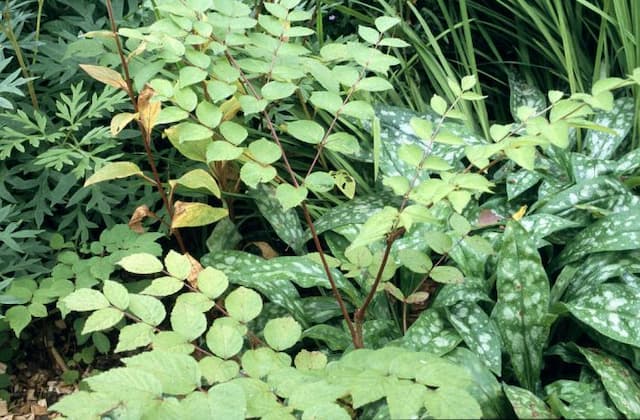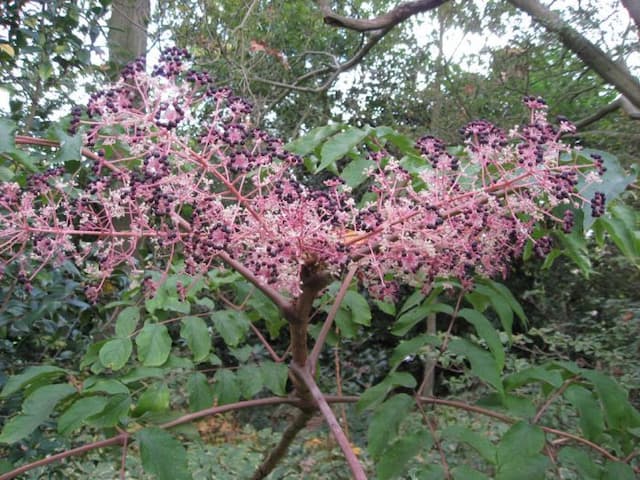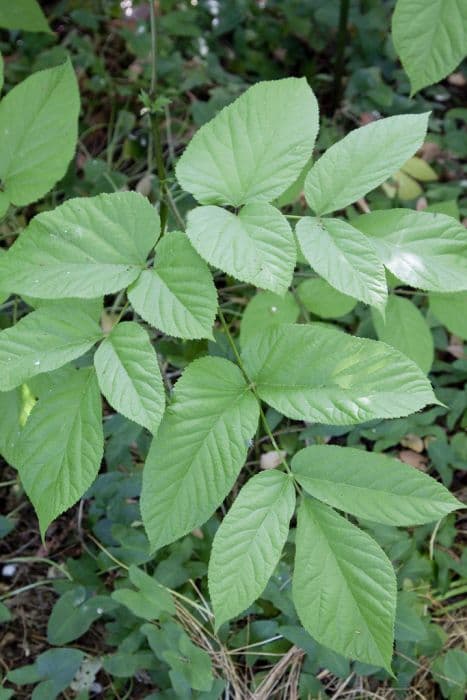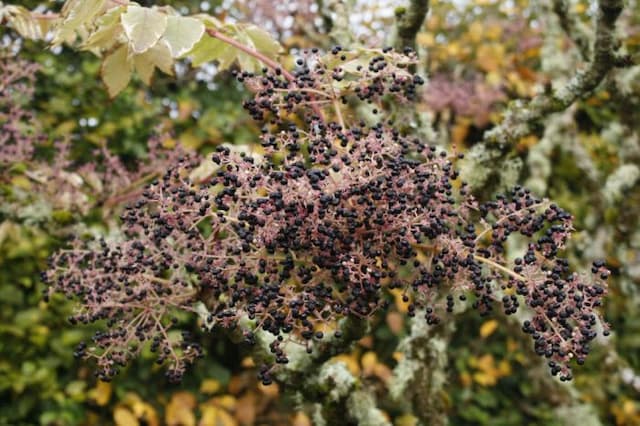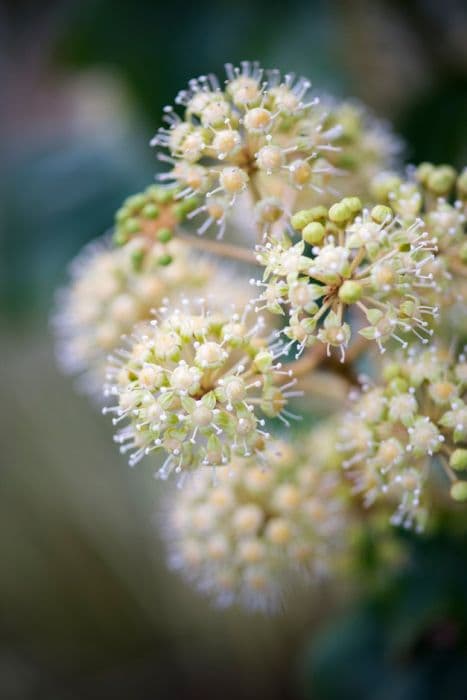Udo Aralia cordata Thunb.

ABOUT
Aralia cordata, commonly known as spikenard, is a plant that boasts a robust and herbaceous presence. Its leaves are large and double pinnate, meaning they have a feather-like appearance with smaller leaflets arranged on either side of a common axis. The leaflets themselves are bright green, giving the plant a lush and vibrant look. Throughout the growing season, the plant displays an abundance of these sizable leaves, creating a dense and lush foliage. The spikenard produces small, globular flowers that are usually greenish or white in color. These flowers grow in impressive umbrella-shaped clusters known as panicles, which can catch the eye due to their arrangement and multitude. After the flowering period, the plant develops small, fleshy berries. These berries typically take on a dark coloration when ripe, ranging from deep purple to black. Overall, the spikenard has an appearance that can add a touch of wild and natural beauty to a garden. Its large, textured leaves are often the main attraction, but the unique structure of its flowers and the subsequent berry clusters also contribute to its decorative appeal.
About this plant
 Names
NamesFamily
Araliaceae.
Synonyms
Udo, Japanese Spikenard, Mountain Asparagus, Aralia Shoot, Spikenard.
Common names
Aralia edulis Siebold & Zucc., Aralia nutans Miquel, Aralia cordatifolia Hort. ex K.Koch, Aralia taiwaniana Koidz.
 Characteristics
CharacteristicsLife cycle
Perennials
Foliage type
Deciduous
Color of leaves
Green
Flower color
Greenish
Height
3-6 feet (0.9-1.8 meters)
Spread
2-3 feet (0.6-0.9 meters)
Plant type
Herb
Hardiness zones
4
Native area
Japan Korea
Benefits
 General Benefits
General Benefits- Edible Shoots: Aralia cordata, commonly known as "Udo" in Japan, produces shoots that are consumed as a vegetable, often blanched and used in salads or cooked in various dishes.
- Ornamental Value: With its large, bright green leaves, Udo adds aesthetic value to gardens and landscapes.
- Wildlife Habitat: The plant can provide shelter and habitat for various species of wildlife, including beneficial insects.
- Culinary Versatility: Udo is used in a variety of culinary applications, from pickles to tempura, adding unique flavors to a wide range of dishes.
- Cultural Significance: In some cultures, Udo is used in traditional events and ceremonies, and is intertwined with local customs and culinary traditions.
- Soil Improvement: The deep roots of Udo can help improve soil structure and fertility by breaking up compacted layers and enriching the soil with organic matter.
 Medical Properties
Medical Properties- Anti-inflammatory: Aralia cordata has been traditionally used for its potential to reduce inflammation.
- Diuretic: The plant may promote the excretion of urine, aiding in fluid balance and kidney function.
- Analgesic: It is believed to have pain-relieving properties.
- Hepatoprotective: There is some evidence suggesting that Aralia cordata may help protect the liver.
- Antioxidant: Compounds in the plant may counteract oxidative stress and protect cells from damage.
- Immune system modulation: It might have effects on the immune system regulation.
 Air-purifying Qualities
Air-purifying QualitiesThis plant is not specifically known for air purifying qualities.
 Other Uses
Other Uses- Aralia cordata, commonly known as Japanese spikenard, can be used as a natural dye for fabrics, offering a range of greens and yellows depending on the mordant used.
- In floral arrangements, Japanese spikenard adds both height and a touch of the wild, forested look with its large leaves and towering stems.
- The young shoots of Japanese spikenard can be blanched and candied, serving as a unique confectionery or decoration for desserts.
- The plant's large leaves can be used as natural wrappers for cooking, similar to banana leaves, adding a subtle flavor to steamed dishes.
- Japanese spikenard is sometimes grown as an ornamental plant in water gardens because it can thrive in moist soil near ponds or streams.
- Its robust root system can help with soil stabilization on slopes and prevent erosion in garden landscapes prone to weathering.
- In craftwork, the dried stems of Japanese spikenard may be used in basket weaving, contributing a rustic aesthetic to handmade products.
- Garden enthusiasts sometimes use the plant to create a natural garden screen or living fence due to its dense foliage and fast-growing nature.
- Beekeepers value Japanese spikenard flowers as they are good nectar sources, thus helping to feed bees and encourage pollination in the garden.
- As a companion plant in vegetable gardens, Japanese spikenard can help to provide shade for cooler weather crops that require protection from intense sunlight.
Interesting Facts
 Feng Shui
Feng ShuiThe Japanese Spikenard is not used in Feng Shui practice.
 Zodiac Sign Compitability
Zodiac Sign CompitabilityThe Japanese Spikenard is not used in astrology practice.
 Plant Symbolism
Plant Symbolism- Resilience: Aralia cordata, also known as Udo, often symbolizes resilience because it can grow in difficult soil conditions and recovers well from environmental stress.
- Vitality: Udo has a vigorous growth habit, which makes it a symbol of vitality and thriving energy.
- Purification: In some cultures, Udo is considered to have purifying properties, and thus symbolizes cleansing and renewal.
 Water
WaterUdo, or mountain asparagus, requires consistent but moderate watering, usually around 1 to 1.5 gallons per week, depending on the local climate and soil conditions. It's vital not to let the soil get completely dry, but also to avoid waterlogging, which can lead to root rot. During the growing season in spring and summer, it may need more frequent watering, especially in warmer weather. Always check the top inch of soil for dryness before adding water. In winter, you can reduce watering as the plant's growth slows down.
 Light
LightUdo thrives in partial shade to full sun. It is best positioned where it can receive bright, indirect sunlight for most of the day. Direct midday sun can be harsh, so a spot that offers some shelter during the hottest part of the day is ideal. Indoor plants will benefit from a north or east-facing window that provides ample but diffused light.
 Temperature
TemperatureUdo plants prefer moderate temperatures and should be kept in an environment where the temperature remains between 60°F and 80°F. They can tolerate a minimum temperature of 50°F, but anything below can be harmful to the plant. The ideal conditions would mimic their natural forest habitat, so avoid exposure to extreme heat or cold drafts.
 Pruning
PruningPruning Udo helps maintain its shape, encourage new growth, and remove any dead or damaged leaves. It is best to prune in late winter or early spring before new growth begins. You typically only need to prune it once a year, trimming back the tops and any overly long shoots, but regular inspections for dead material can be beneficial.
 Cleaning
CleaningAs needed
 Soil
SoilUdo prefers a rich, moist, well-draining soil mix with a pH of 5.5 to 7.5. Amend the soil with compost or peat moss to enhance fertility and structure.
 Repotting
RepottingUdo should be repotted every two to three years or when the roots outgrow the current pot.
 Humidity & Misting
Humidity & MistingUdo thrives at high humidity levels, ideally 60-80%. Maintaining these levels will promote lush growth.
 Suitable locations
Suitable locationsIndoor
Place Udo in bright, indirect light indoors and maintain high humidity.
Outdoor
Plant Udo in partial shade and keep soil consistently moist.
Hardiness zone
4-9 USDA
 Life cycle
Life cycleAralia cordata Thunb., commonly known as Udo, begins its life cycle as a seed that germinates in the spring after stratification through winter cold. Seedlings emerge and establish a root system, and in the following years, the plant develops a rosette of large, compound leaves. Udo is a perennial and will enter a period of dormancy in the winter, wherein above-ground foliage dies back. As it matures, the plant will produce a tall flower stalk in the summer of the second or third year, bearing small, white flowers that are attractive to pollinators. Following pollination, flowers develop into small, dark berries that contain seeds, which can be dispersed by birds and other wildlife to begin a new cycle. If conditions permit, Udo can also spread vegetatively through its rhizomatous root system.
 Propogation
PropogationPropogation time
Spring to Summer
Propogation: Aralia cordata, commonly known as Japanese Spikenard or Udo, is typically propagated through seed or division. The most popular method of propagation for this plant is by division, which tends to be more reliable and faster than seed propagation. This process involves digging up an established clump of the plant in early spring or fall, when the plant is not actively growing. The clump should be gently separated into smaller sections, making sure that each section has a portion of the root system. It is important to plant these divisions promptly into well-prepared soil at the same depth they were originally growing, and water them thoroughly. Direct sunlight should be avoided for a few days to allow the divisions to establish without stress. This method allows gardeners to quickly increase their stock of Aralia cordata while ensuring the new plants are true to the parent's characteristics.
